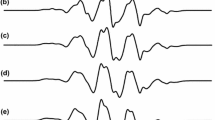Abstract
EPR dosimetry is characterized by its non-destructive read-out and the possibility of dose archival. Here, taurine is proposed as a radiation dosimeter using EPR spectroscopy. The EPR spectrum of taurine was studied and assigned, and changes in the taurine EPR spectrum as a result of the change in both modulation amplitude and microwave power were quantified. For gamma radiation, the energy absorption coefficient and the collision mass stopping power of taurine were compared to the corresponding values of soft tissue and alanine, in addition to calculation of effective atomic numbers. The response of taurine to gamma radiation doses in the range from 0.1 to 50 kGy was investigated, as well as that in the range from 1.0 to 20.0 Gy using numerically enhanced EPR taurine spectra. Both response curves showed a linear behavior. In addition, the time dependence of radiation-induced radicals was studied for short (during the first 6 h after irradiation) and long (during about 3 months after irradiation) time periods, and a reasonable degree of stability of the taurine radicals was observed. It is concluded that taurine is a promising dosimeter, which is characterized by its simple spectrum, radical stability, and wide range of linear response to gamma radiation.










Similar content being viewed by others
References
Attix F (1986) Introduction to radiological physics and radiation dosimetry. Wiley, London
Attix F, Roesch W, Tochilin E (1972) Radiation dosimetry-volume I, 2nd edn. Academic press, New York
Birdsall TC (1998) Therapeutic applications of taurine. Altern Med Rev 3(2):128–136
Bulut A, Karabulut B, Tapramaz R, Kŏksal F (2000) EPR studies of gamma-irradiated taurine single crystals. Radiat Phys Chem 58:149–152
Chen Z, Xu G, Specht K, Yang R, She S (1994) Determination of taurine in biological samples by reversed-phase liquid chromatography with precolumn derivatization with dinitrofluorobenzene. Anaytica Chimica Acta 296:249
Chen F, Graeff CFO, Baffa O (2007) Response of l-alanine and 2-methylalanine minidosimeters for K-Band (24 GHz) EPR dosimetry. Nucl Instrum Methods Phys Res Sect B Beam Interact Mater At 264(2):277–281
Hagar HH, El Etter E, Arafa M (2006) Taurine attenuates hypertension and renal dysfunction induced by cyclosporine A in rats. Clin Exp Pharmacol Physiol 33:189–196
Haskell EH, Hayes RB, Kenner GH (1998) A high sensitivity EPR technique for alanine dosimetry. Radiat Prot Dosimetry 77(1–2):43–49
Hessinger D, Bauer C, Hubrich M, Jeschke G, Spiess W (2000) Magic-angle sample spinning electron paramagnetic resonance-instrumentation, performance, and limitations. J Mag Resonan 147:217–225
Heydari MZ, Malinen E, Hole EO, Sagstuen E (2002) Alanine radicals. 2. The composite polycrystalline alanine EPR spectrum studied by ENDOR, thermal annealing, and spectrum simulations. J Phys Chem A 106:8971–8977
Hubbell J, Seltzer S (1995) Tables for mass attenuation coefficients and mass energy-absorption coefficients 1 keV to 20 MeV for elements Z = 1 to 92 and 48 additional substances of dosimetric interest. U.S. Department of commerce, NIST report (NIST-IR-5632), ionizing radiation division, Gaithersburg, USA
ICRU (1984) Stopping powers for electrons and positrons. Report 37. International Commission on Radiation Units and Measurement, Bethesda, MD
ICRU (1989) Tissue substitutes in radiation dosimetry and measurements. Report 44, International Commission on Radiation Units and Measurements, Bethesda, MD
L’Amoreaux WJ, Cuttitta C, Santora A, Blaize JF, Tachjadi J, El Idrissi A (2010) Taurine regulates insulin release from pancreatic beta cell lines. Biomed Sci 17(Suppl 1):S11
Lind G, Kewley R (1972) Electron spin resonance of g-irradiated taurine. Can J Chem 50:43–49
Lund A, Olsson S, Bonora M, Lund E, Gustafsson H (2002) New materials for ESR dosimetry. Spectrochimica Acta A 58:1301–1311
Lund E, Gustafsson H, Danilczuk M, Sastry M, Lund A, Vertad T, Malinen E, Hole E, Sagstuen E (2005) Formates and dithionates: sensitive EPR-dosimeter materials for radiation therapy. Appl Radiat Isotopes 62:317
Maghraby A (2007) A sensitive EPR dosimetry system based on sulfamic acid. Nucl Instrum Meth Phys Res B 262:46–50
Maghraby A, Tarek E (2006) A new EPR dosimeter based on sulfanilic acid. Radiat Meas 41:170–176
Maghraby A, Salama E, Mansour A (2011) EPR/homotaurine: a possible dosimetry system for high doses. Nucl Instrum Meth Phys Res A 659(1):504–507
Malinen E, Hult EA, Hole EO, Sagstuen E (2003a) Alanine radicals, part 4: relative amounts of radical species in alanine dosimeters after exposure to 6–19 MeV electrons and 10 kV–15 MV photons. Radiat Res 159:149–153
Malinen E, Heydari MZ, Sagstuen E, Hole EO (2003b) Alanine radicals, part 3: properties of the components contributing to the EPR spectrum of X-irradiated alanine dosimeters. Radiat Res 159:23–32
Monograph (2001) Taurine. Altern Med Rev 6(1):78–82
Nagy V, Desrosiers M (1996) Complex time dependence of the EPR signal of irradiated L-α-alanine. Appl Radiat Isot 47:789–793
Olsson SK, Lund E, Lund A (2000) Development of ammonium tartrate as an ESR dosimeter material for clinical purposes. Appl Radiat Isotopes 52:1235–1242
Sagstuen E, Hole E, Haugedal S, Nelson W (1997) Alanine radicals: structure determination by EPR and ENDOR of single crystals X-irradiated at 295 K. J Phys Chem A 101(50):9763–9772
Schaffer SW, Jong CJ, Ramila KC, Azuma J (2010) Physiological roles of taurine in heart and muscle. J Biomed Sci 17(Suppl 1):S2
Schuller-Levis GB, Park LE (2003) Taurine: new implications for an old amino acid. FEMS Microbiol Lett 226:195–202
Wu JY, Prentice H (2010) Role of taurine in the central nervous system. J Biomed Sci 17(Suppl 1):S1
Yamori Y, Taguchi T, Hamada A, Kunimasa K, Mori H, Mori M (2010) Taurine in health and diseases: consistent evidence from experimental and epidemiological studies. J Biomed Sci 17(Suppl 1):S6
Yang J, Wu G, Feng Y, Lv Q, Lin S, Hu J (2010) Effects of taurine on male reproduction in rats of different ages. J Biomed Sci 17(Suppl 1):S9
Acknowledgment
A. Maghraby appreciates the support of Dr. Khaled Alzimami, Assistant professor at the Department of Radiological Sciences, King Saud University, Riyadh, for revising this manuscript and for valuable discussions.
Author information
Authors and Affiliations
Corresponding author
Rights and permissions
About this article
Cite this article
Maghraby, A., Mansour, A. & Tarek, E. Taurine for EPR dosimetry. Radiat Environ Biophys 51, 255–261 (2012). https://doi.org/10.1007/s00411-012-0415-z
Received:
Accepted:
Published:
Issue Date:
DOI: https://doi.org/10.1007/s00411-012-0415-z




